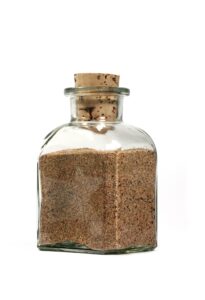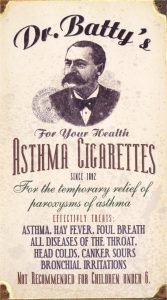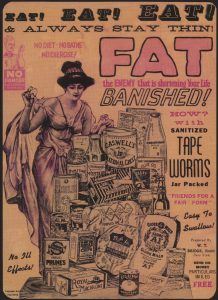THE COMING EPIDEMIC!
THE COMING EPIDEMIC!!
———————————-
SALT REGAL A PREVENTIVE AND SAFEGUARD!!
EXTRACT FROM LONDON PRESS—
TELEGRAMS FROM BERLIN AND VIENNA state “that the Epidemic of
Influenza, which has been playing such havoc in Russia, has now spread to Germany and Austria, and will shortly make its appearance in England”
FORTIFY YOURSELVES
Against the attacks of this and all diseases by using the pleasant and refreshing
SALT REGAL
Heads of Families NEED HAVE NO FEAR of Infectious Diseases for themselves
or their children if they will use SALT REGAL. Influenza, Fevers, Malaria, Cholera, and the like are harmless to those who use SALT REGAL. See Analysis and authentic Testimonials with every Bottle.
The Press and Public declare SALT REGAL to be a pleasant and refreshing SAFE-GUARD AGAINST DISEASE. There is no preparation like it in the world.
SOLD EVERYWHERE, 1s. 6d. and 2s. 9d.
PROTECTED BY HER MAJESTY’S ROYAL LETTERS PATENT
Source: The Graphic, Sat 4 Jan, 1890
Salt Regal, the “King of Effervescents,” was in a similar vein to Eno’s Fruit Salt, and formed a pretty pink fizzy drink when mixed with water. It enjoyed a brief period of fame between about 1887 and the turn of the 20th century, and was advertised widely with claims ranging from the wild – e.g. that it would prevent influenza and cholera – to the vague:
…a high-class Antiseptic Salt, possessing hygienic properties hitherto unknown to science. A grateful, cooling cup, developing Ozone (the principle of life). Will cleanse the mouth, clear the throat, sweeten the breath, and maintain a natural condition of the system. Corrects all the impurities arising from errors of diet – eating or drinking. Salt Regal has the special property of purifying the water in which it is mixed.
Adverts often contained ‘analyses’ by some of the eminent chemists of the day, including A. Norman Tate, John Muter (click for pic of his epic moustache) and Henry Thomas Jones, but they were similarly wishy-washy and never actually said what was in the product:
I have examined the example of SALT REGAL handed to me some time ago. I find it to be a very carefully prepared saline. Its special feature is that is contains a small proportion of a very useful antiseptic, the value of which in such a preparation must be very great. Its use in warm climates will be found to be most valuable, both on account of its gentle aperient qualities, and of its antiseptic property. HENRY THOMAS JONES, F.I.C., Asst Professor of Chemistry, University of Aberdeen.
I don’t know whether the analysts’ names were used without their permission, or whether their testimonials comprised the best bits from genuine reports, but it seems unlikely that these top chemists would write up an analysis without even mentioning any ingredients.
As for “The Coming Epidemic!!,” by the time of this advert, it was already here. The Russian Flu reached the UK at the very end of 1889. Concern had been building up for several weeks, as reports came in of high mortality in Moscow and a rapid spread of the disease across Europe. Some reporters were less worried – The Daily News‘s Paris correspondent, for example, pointed out that “La Grippe” was prevalent every winter, and while the elderly or very young might suffer complications, for most people the disease ran its course within a few days.
Other reports scraped the barrel for evidence of dire consequences – in Vienna, said The Birmingham Daily Post:
The Christmas festivities have been interfered with to a very great extent by the epidemic, and the usual Christmas tree was missing from the homes of one-third of the families in this city, owing to sickness.
While the British just about got through Christmas intact, by the New Year the flu had arrived, apparently bearing “a special grudge against post-office officials,” as postmen in suburban offices rapidly succumbed. Some people blamed the post for spreading the disease across the country.
Orthodox treatment usually involved quinine, but the main way of getting over the flu was to stay in bed for a few days and keep warm. Looking back a year later, the Bristol Mercury was rather dismissive of the mildness of the epidemic. As it happened, they spoke too soon – the flu returned with a vengeance in the spring of 1891, and again later that year, with worse outbreaks occurring over the next few winters. The Mercury‘s comment is nevertheless amusing for its relevance today:
The influenza was the fashion of the hour, and everyone who could manage two or three consecutive sneezes satisfied themselves that they were suffering from the prevalent complaint.




Most timely!
I love that header ‘The coming epidemic. The coming epidemic’ it could quite easily be helicoptered into some of our modern papers without the batting of a single eyelid. In fact I’m pretty sure the mail ran that headline earlier in the year…
Caroline, thanks for another fascinating post.
Unsubstantiated claims for flu remedies are still being made, for example:
http://www.healthstuff.co.uk/Models.aspx?ModelID=1902
Thanks Caroline – fabulous post illustrating how ‘panics’ grow out of hand – then and now!
The ad caught my eye precisely because of that familiar tone. I’m sure the Mail would recommend their cure-all, vinegar, rather than Salt Regal, but the principle is the same!
Especially because since posting this I’m starting to get a very slight sore throat…
Blimey, that’s some strong claim. Aconite was in use at the time of the above ad and earlier, and I can understand that in a normal dose of flu it probably appeared to work as well as anything else, but where acute infections are concerned, well…
Thank you – it would be interesting to go into more depth about the perception of epidemics compared with the behaviour of the epidemics themselves throughout history.
I would love to know if people in 1890 were telling Russian flu jokes!
@Caroline
“Especially because since posting this I’m starting to get a very slight sore throat…”
Don’t worry. You have Jerome K Jerome syndrome, which is very common. — see http://www.bmj.com/cgi/content/extract/339/oct14_2/b4194